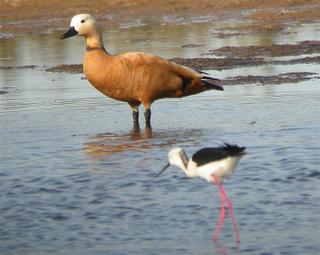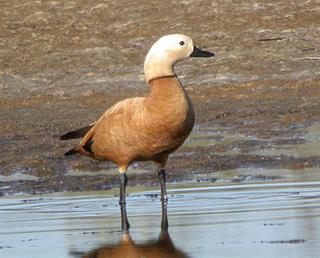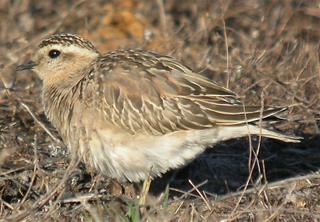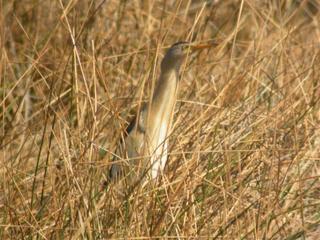SPEA / RSPB Algarve visit – March 2005
From 29 March - 1 April a joint delegation from SPEA (BirdLife Portugal) and the RSPB (BirdLife International in the UK) visited the Algarve. The joint delegation undertook a series of meetings with the President and other technical staff of Comissão de Coordenação de Desenvolvimento Regional (CCDR Algarve, the land planning agency) and with the CEO and technical staff from Águas do Algarve SA (the regional water company). The delegation was comprised of Luis Costa (Executive Director, SPEA) and Jose Tavares (RSPB Country Programmes Officer for Portugal, Greece and Turkey), João Ministro (local IBA Caretaker), and Matt Self (senior RSPB Reserves Ecologist).
SPEA / RSPB study on the land-use zonation & hydrology of the lagoon
As confirmed to all stakeholders late last year, SPEA and the RSPB are now jointly undertaking this study. The resulting report will be made available in May, and will inform the debate and decisions being taken on Lagoa dos Salgados. João Ministro is currently writing up the zonation analysis that will map in detail the relevance of the margins of the lagoon for the various wintering and breeding bird species. Matt Self undertook fieldwork over a period of several days at the site last week to complete the site hydrological assessment. This will cover issues including the annual cycle of flooding and drying, water volume and quality, water budget to determine supply requirements, and water inputs and outputs.
Environmental Impact Assessment of the proposed Water treatment plant
At the meetings held in October 2004 with key stakeholders, one of the main concerns identified regarding this site was that the new water treatment plant, to be constructed a few miles away, would not provide any water to the lagoon. The wetland is currently extensively fed by water from an old treatment plant close to the lagoon that will be decommissioned once the new one is ready. The original plans for the new treatment plant, drawn up many years ago, did not include any outflow to the wetland. Therefore, in recent months SPEA / RSPB have written and lobbied both the CCDR and Águas do Algarve to ensure that the Environmental Impact Assessment (EIA) study for the new plant would consider the water needs of the lagoon. A crucial step in this procedure is the establishment of the terms of reference for the EIA study, which are set by an EIA Follow-up Commission that is established for each specific EIA. It is encouraging that because of the recent discussions both the CCDR and Águas do Algarve have confirmed that in the Water Treatment Plant EIA Follow-up Commission defined that the EIA must analyze the water needs of Lagoa dos Salgados. A private consultancy company is currently undertaking the EIA study, so the results are not yet public. The study currently being completed by SPEA and the RSPB aims to inform and contribute to this EIA. As soon as the EIA report is released to the public SPEA and the RSPB will jointly analyze its findings.
CCDR position on proposed development
CCDR confirmed to SPEA / RSPB that they are maintaining their previous binding opinion that the proposed golf course and large-scale tourism resort planned for the west of the lagoon can only be built above the 4 m above sea level height contour (deemed to be the historical flooding height). They have maintained their position in spite of the recent legal, but non-binding opinions from the Instituto da Agua, and the Camara Municipal de Silves, dismissing the 4m criteria. This is good news as it means at present the development still has not been approved. The emphasis is now on the developers, who will have to resubmit a counter-proposal to CCDR.
December 2004 Lagoon opening
It has been confirmed that the most recent opening of the lagoon to the sea in December 2004, was legal and officially sanctioned. As mentioned previously, the CCDR can give permission for the dunes to be breached between December and February (inclusive). The existing golf course company on the east side of the marsh is usually the company that request authorization, because their facility is periodically flooded by high water during the winter. It was confirmed that late in 2004, the golf course company applied, and received permission to open the wetland to the sea. The marsh dried out considerably because of creating the channel to the sea. However, barely two months later, the water levels had recovered to the initial level. A good range of bird species were seen in good numbers, including hundreds of flamingos. However, the water quality was extremely poor as winter 2004/5 has been very dry, with almost no rain throughout. As a result, the wetland’s water predominantly originates from the current sewage treatment plant that is not working effectively. It is highly probable that this coming summer will witness another botulism eruption that would be expected to cause the now familiar summer mortality of birds.
Lagoa de Salgados – Siltation problem identified
In the lengthy technical discussions held with engineers and technicians from both CCDR and Águas do Algarve different alternatives to correctly manage the water level and quality of this wetland have been analyzed and discussed. These alternatives will be listed in the SPEA / RSPB report. A new issue regarding the water management at this site has also been identified. The opening of the lagoon to the sea during the winter months is currently necessary for two reasons. Firstly, this releases the polluted water, but additionally to purge the considerable volume of silt that accumulates rapidly in the wetland. This siltation comes in part from the vast amounts of treated sludge emanating from the old water treatment plant. It is clear that without regularly opening the lagoon to the sea, Lagoa dos Salgados would rapidly then silt up.
Kite-surfing problem emerges
Finally, a local SPEA member has recently informed SPEA of a new threat to Lagoa dos Salgados from people kite-surfing on the lagoon. It is inconceivable that anyone would want to pursue this sport in such polluted waters, especially as such good conditions for this sport exist out at sea in Praia Grande nearby, but this has happened on more than one occasion. Each time this has caused an enormous amount of disturbance to the birds foraging in the area. SPEA have already alerted CCDR and the local police force about this problem, and asked what can be done to prevent this being repeated, especially through any legal instrument, taking into consideration the Birds Directive.
SPEA to meet Ministry of Environment
SPEA will be meeting the new Deputy Environment Minister of the new Portuguese government in April. Among a number of national and site-based issues on the agenda, SPEA will raise the plight of the Lagoa dos Salgados, and the need for some legal protection of the lagoon as a Special Protected Area under the Birds Directive.
If any of these points require clarification, please contact me directly. I will circulate a further update on developments in July 2005.
Yours sincerely,
José Pedro Tavares
Country Programmes Officer for Portugal, Turkey and Greece
International Division
The RSPB
The Lodge
Sandy
Bedfordshire SG19 2DL, UK
E-Mail: jose.tavares@rspb.org.uk
Luis Costa
Director
SPEA
Rua da Vitória, 53 -3º Esq
1100-618 Lisboa, Portugal
E-Mail: luis.costa@spea.pt
This update, produced jointly by the RSPB and SPEA, was circulated on 7th April 2005. It has some very positive points and in repsonse to this I wrote (via email on 10th April) directly to Jose Tavares (RSPB Country Operations Officer for Portugal).
This was my response:
Dear Jose,
Thank you for your email of 7th April and the update on the situation with Lagoa dos Salgados. I am sure I speak on behalf of many people, in addition to those to whom the update was copied, in saying that I am very pleased with the progress that has been made to date and I congratulate you and your colleagues at SPEA and Almargem for your hard work. I am pleased not just because there are now some concrete results and some cause for optimism, but also because you have made the debate public. This was the cause of much frustration, if not anger, in the past - no-one actually knew what the situation was. The very large number of birdwatchers visiting this site each year, many of them having done so for several years, could only base their opinions on what they saw for themselves: constantly encroaching development, badly polluted water and periodic draining of the lagoon at apparently inappropriate times when birds were nesting. I myself was totally unaware of most of the information which you have released over the past six months regarding the large number of interested parties involved and the overall complexity of the situation.
The two most positive notes are that the EIA Follow-up Commission is requiring the Environmental Impact Assessment to include the water needs of Lagoa dos Salgados, and that the CCDR are maintaining their stance that development to the west of Salgados should be above the 4 metre sea height flooding contour. I do not yet see victory in these matters; I have lived in the Algarve long enough to know that the Portuguese "machinery" moves in mysterious ways and where developers and local government politics are concerned there is no such thing as "an insurmountable hurdle". Let us hope that things proceed for the benefit of the lagoon and its birdlife.
Regarding your statement on the December 2004 Lagoon opening being legal and officially sanctioned, I remain unconvinced about some aspects of this. Clearly the Salgados Golf Club is the prime activator in this, but I am not sure about their motives. I have never seen (or heard) any evidence of the golf course being flooded, even when the water level in the lagoon was very high two winters ago. The water level certainly was not high enough to be a flooding risk when the lagoon was drained in December last year. I happened to meet four golfers recently at Salgados who were regular players on this course. They told me that when the water in the lagoon becomes unpleasantly smelly, and players complain to the club, they arrange to have the lagoon drained regardless of timing and deleterious effect on the birds. We must accept the necessity for period draining until such time as (hopefully) a cleaner source of water feeds the lagoon, but I think that in the past it has been done (e.g. in late March 2004) at an inappropriate time. Also, I do not accept the golf club's denial that they are taking water from the lagoon (or at least the stream which feeds the lagoon); I, and others, have witnessed this first hand.
The kite-surfing problem which you mention is worrying. This is not something I have witnessed at Salgados but it is becoming a very popular nuisance across the Algarve and I see the effect it has on the thousands of roosting birds in the Ria da Alvor, where I live. I am not sure whether the local police are the people to cope with this; they have been alerted to the illegal shooting of ducks, etc (from the birdwatching hide!) and equally illegal mist-netting to trap birds coming in to roost in the evening, but have failed to take any action. I have a contact (Capt. Rui Moreira) within the SEPNA (Equipa de Proteccao da Natureza) branch of the GNR in Portimao who could be more effective. [contactable on Tel: 282 420750 TM: 96 1193296 Linha Azul: 808200520] They are over-worked and under-staffed but are very keen to tackle any "crime against nature" - I will try to contact them about this but it might be useful if a more "official" approach could be made by SPEA and Almargem. Otherwise, let us hope that the lagoon becomes strewn with the half-commatose bodies of people in wetsuits suffering from surfer's botulism.
The forthcoming meeting of SPEA with the new Portuguese Deputy Environment Minister sounds encouraging. If, at the end of the day, Lagoa dos Salgados can be elevated from an IBA to an SPA then I think that the future of this very special site might become more secure. It really is worth preserving; it might rank lower than other deserving Portuguese sites in terms of total area and actual numbers of birds, but for its size it has an incredible number of birds and variety of species, including many rarities, and it also has the very special quality of easy accessabilty, and that is of prime importance in terms of educating Portuguese schoolchildren (and possibly even their parents) and at the same time attracting eco-tourism.
I look forward to hearing news, hopefully good news, of further developments.
My very best wishes,
Colin Key
I did not receive either an acknowledgement or reply, and we are now awaiting the promised further update due this month (July).
Here are some photographic reminders of some of the threats which we are fighting against:

A view to the east of Lagoa dos Salgados where five 5-star hotels and accompanying recreational support is being constructed - this will complete the development of the coastal strip between Albufeira (the "Blackpool" of the Algarve) and the Lagoa dos Slagados golf course. At the moment there are proposals to continue development on the west side of the Lagoa as far as Armacao da Pera and current plans indicate that this development will touch the western edge of the flood - the consequences of this are probably that the current expanse of water will cease to exist (together with the supported population of birds).
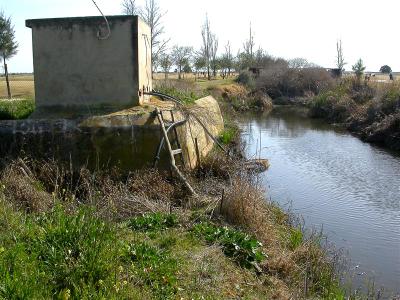
This is the pump-house which both SPEA and the RSPB deny exists - it is taking water from the stream which supplies the Lagoa to provide irrigation for the Salgados golf course.
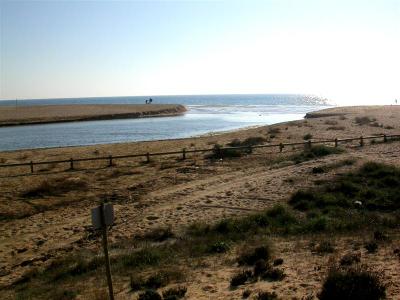
The beach at Praia Grande, the south-east corner of the Lagoa, where the dunes are periodically breached by bulldozer to allow the heavily polluted water to escape to the sea. RSPB and SPEA claim that this is done to "simulate natural processes" and that it is done "sensitively" so as not to disturb the birds. I have evidence that this is done indiscriminately at the bequest of the golf club, not (as has been said) to prevent flooding of the greens, but because the smell of the sewage-polluted water is offensive to the golfers. Last year draining took place in late March when most birds had already nested and were sitting on eggs.
SOME GOOD NEWS
In recent weeks there has been an attempt to revive the lagoon as an environmetal asset. The local Camara Municipal (District Council) of Silves had erected a birdwatching hide, nature trail and numerous information boards. The hide went into disrepair, part of the trail was closed off and all the information boards were removed eighteen months ago in what many thought was a prelude to obliterating the lagoon completely. In recent weeks the hide has been repaired and several new, informative boards in both English and Portuguese have been erected.


We are still a long way from achieving a victory but the actions of the RSPB and SPEA are now more positive, there is an information-flow, and an attempt is being made to co-ordinate the views and wishes of all parties involved. I have heard recently that an application is being made to have Lagoa dos Salgados given the status of a RAMSAR Site which might be another step in raising the site's level of protection from IBA (Important Bird Area) to SPA (Special Protection Area); the latter would almost certainly guarantee the site's future preservation. I would like to thank everyone who has written to the RSPB and/or SPEA to express their concerns and offer support for this crusade and to especially thank Derek Honnor, without who's initial protestations to the RSPB at their headquarters in Sandy, the progress seen in recent months would not have taken place.
